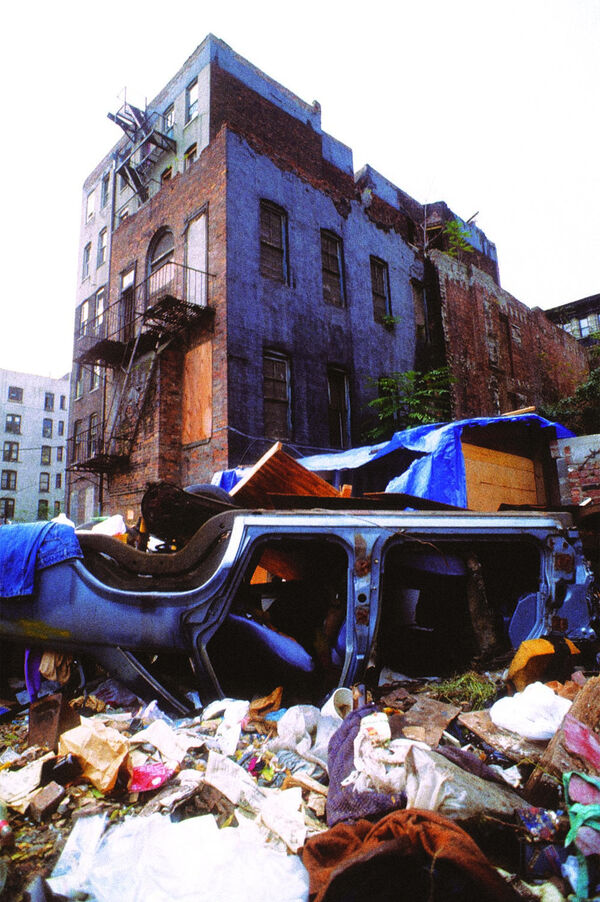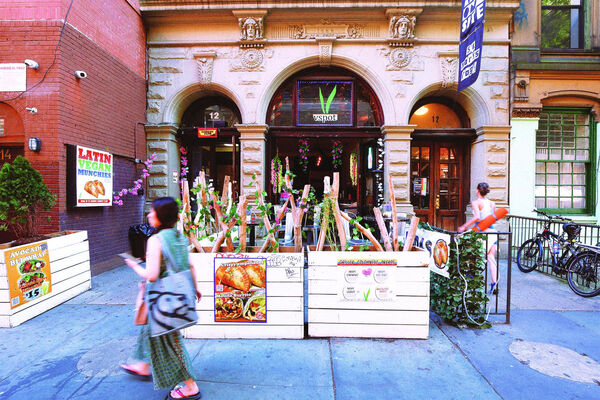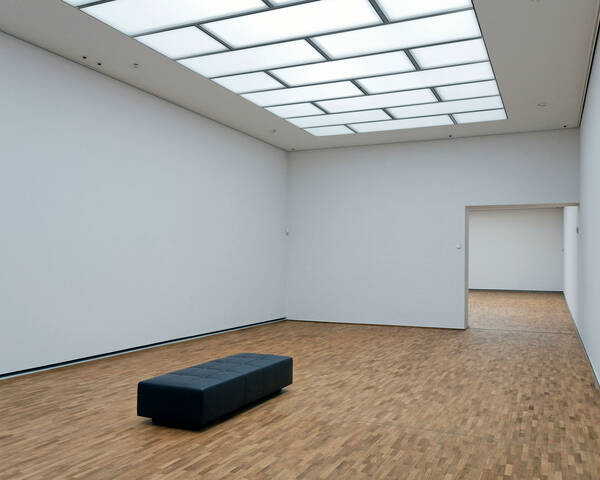Edifice Complex

Restoring the term “burnout” to its roots in landlord arson puts the dispossession of poor city dwellers at its center.
Abandoned and burned-out buildings in the East Village in 1986.
If burnout has a birthplace, it can be found in the tenemented expanse of New York’s East Village. There, in the early 1970s, a psychologist named Herbert Freudenberger made a nightly trek to the St. Mark’s Free Clinic, where he served as a volunteer counselor to the throng of hippie youth who congregated nearby. He’d arrive around 6:00 pm after putting in a full day at his buttoned-down practice on Park Avenue. To get to St. Mark’s, he had to traverse an East Village in the midst of a far-reaching pattern of state and capital disinvestment, its streets and avenues pockmarked with burned-out buildings. Some areas, particularly those home to a sizable Puerto Rican community, lost more than half of their housing to fire and abandonment during the 1970s. The most destructive fires were set or commissioned by landlords, who collected enormous sums in the resulting insurance payouts. Black and brown neighborhoods across the city and nation were ravaged by the arson wave, which was fueled by subprime fire insurance policies that saturated neighborhoods of color after 1968. The peak hours for arson in these years fell just after midnight, around the time when Freudenberger tended to leave the clinic for the night.
In 1971, after putting in a year of 16-hour days, the psychologist found himself unable to get out of bed. When Freudenberger searched for an evocative term to describe his experience of intense exhaustion, he landed on “burnout,” a word he borrowed from his patients. In these early days of the free clinic movement, which began in San Francisco’s Haight-Ashbury neighborhood in 1967, treatment centers were established primarily to help people in the throes of a bad trip. LSD users who came to the St. Mark’s clinic, and later users of heroin and barbiturates, introduced Freudenberger to the term, slang for the effects of chronic drug use. Neglecting to credit his patients or acknowledge the term’s association with narcotics, Freudenberger instead referenced the ruins surrounding the clinic. “If you have ever seen a building that has been burned out,” he wrote in the opening lines of his 1980 bestseller Burn-Out: How to Beat the High Cost of Success, “you know it’s a devastating sight. What had once been a throbbing, vital structure is now deserted. Where there had once been activity, there are now only crumbling reminders of energy and life.”
Freudenberger was tapping into the spatial zeitgeist: The arson wave terrorizing New York City had already become an iconic symbol for the failures of national urban policy. “Arson is our fastest growing crime,” noted Bill Moyers in a 1977 CBS special. “Once, that smoke on the horizon signified industry, progress, jobs. Now it means someone is burning down a building.” Like any good therapist, Freudenberger translated these signs of the times into psychopathology. “As a practicing psychoanalyst,” he wrote, “I have come to realize that people, as well as buildings, sometimes burn out.” For Freudenberger, burnout occurred when one’s “inner resources are consumed as if by fire.” Not reducible to stress, depression, or exhaustion, Freudenberger’s burnout was a symptom of inflated expectations left unfulfilled. “The American dream is no longer a reality,” he told The Los Angeles Times in 1982, “but many of us are still operating as if it were.” If Freudenberger was looking for a symbol that could evoke those dashed dreams, he couldn’t do much better than the burned-out building.
Burnout can be understood as a product of what we might call the urban crisis school of social science, which grew to prominence by interpreting the large-scale problems of industrial relocation, unemployment, redlining, white and capital flight, and deep-seated segregation through the prism of individual and group pathology. Alongside the “inner city,” the “underclass,” and the “culture of poverty”—terms coined by social scientists who used the decimated urban landscapes of the 1960s and ’70s to ground sweeping theories of society—perhaps the most notorious concept to emerge from this intellectual tradition was the broken windows theory of policing. First proposed in a 1982 article in The Atlantic by social scientists James Q. Wilson and George L. Kelling, the theory posited that small signs of disorder—like public drunkenness or graffiti—work to spur more injurious crime. Based on a bad-faith reading of an earlier study on vandalism by social psychologist Philip G. Zimbardo (creator of the infamous Stanford Prison Experiment), the broken windows thesis weaponized the landlord-torched landscape of 1970s New York, ushering in an extreme new regime of policing. The idea of burnout derived from the same social scientific milieu, and though it veered in a less reactionary direction, it similarly pivoted away from left and liberal analyses of urban crisis, underlining personal pathology as opposed to structural forces. Indeed, Zimbardo’s wife and collaborator, the social psychologist Christina Maslach, became the principal theorist and researcher of burnout alongside Freudenberger. Since 1981, Maslach’s Burnout Inventory has been the primary diagnostic tool for the condition in
the US.

An abandoned building and vacant lot in the East Village in 1986.
Unlike broken windows, burnout has shed its roots in the social scientific vision of urban crisis: We don’t tend to associate the term with the city and its tumultuous history. But it’s actually quite telling that Freudenberger saw himself and his burned-out coworkers as akin to burned-out buildings. Though he didn’t acknowledge it in his own exploration of the term, those torched buildings had generated value by being destroyed. In transposing the city’s creative destruction onto the bodies and minds of the urban care workers who were attending to its plight, Freudenberger’s burnout likewise telegraphed how depletion, even to the point of destruction, could be profitable. After all, Freudenberger and his coworkers at the free clinic were struggling to patch the many holes of a healthcare system that valued profit above access.
Many left critics of the burnout paradigm have faulted the concept for individualizing and naturalizing the large-scale social antagonisms of neoliberal times. “Anytime you wanna use the word burnout replace it with trauma and exploitation,” reads one representative tweet from the Nap Ministry, a project that advocates rest as a form of resistance. They’re not wrong. In Freudenberger’s chapter on preventing burnout, for instance, he exhorts us to “acknowledge that the world is the way it is” and warns, “We can’t despair over it, dwell on the pity of it, or agitate about it.” That’s psychobabble for Margaret Thatcher’s infamous slogan, “There is no alternative.” But if we excavate burnout’s infrastructural unconscious—its origins in the material conditions of conflagration—we might discover a term with an unlikely potential for subversive meaning. An artifact of an incendiary history, burnout can vividly name the disposability of targeted populations under racial capitalism—a dynamic that, over time, has ensnared ever-wider swaths of the workforce.
Burnout is not the first work-related infirmity to borrow meaning from the infrastructure of the city. “Exhaustion,” propelled in part by its association with steam engine emissions, initially became a pressing medical concern in the late 18th and early 19th centuries, when it was considered a symptom of industrialization and urbanization. Throughout the 19th century, writes Cara New Daggett in her book The Birth of Energy, “work [became] increasingly understood through energetic metaphors.” This association was catalyzed by the “discovery” of energy itself in the 1840s by a cohort of British scientists and engineers who used steam engine experiments to develop the new laws of thermodynamics. The fledgling field of energy science, born in the industrial landscape, quickly migrated from steam engines to the workers who operated them. Energy management lent meaning to the growing emphasis on worker management, as the new discourses of efficiency and productivity became tools to govern the urban industrial proletariat. These breakthroughs in energy science enabled a simultaneous revolution in neurology, which discovered in the 1840s that the nervous system was powered by electricity. Nerves were likened to electrical wires, the brain to a battery. Out of this concatenation emerged neurasthenia, burnout’s diagnostic forebear, in 1869. Defined as a depletion of nerve energy that caused fatigue, malaise, and chronic pain, neurasthenia was—in the words of its popularizer, the neurologist George Beard—linked to “steampower, the periodical press, the telegraph, the sciences, and the mental activity of women.”
Freudenberger insisted that burnout was distinct from overwork: It required the signature “overdedication” and “overcommitment” he witnessed among workers and volunteers at the St. Mark’s Free Clinic.
Although it was a hazard endemic to industrial capitalism, neurasthenia was considered not so much a peril of railroad or sweatshop work as a malady afflicting the overstimulated Gilded Age elite, especially women. A century later, Freudenberger made a parallel move, insisting that burnout was distinct from overwork: It required the signature “overdedication” and “overcommitment” he witnessed among workers and volunteers at the St. Mark’s Free Clinic. Who was prone to burnout? “Those of us who work in free clinics, therapeutic communities, hot lines, crisis intervention centers, women’s clinics, gay centers, runaway houses,” he wrote in 1975. He saw women care workers as especially vulnerable, thus further accenting the neurasthenic rhyme. In one paper on the sources of burnout, the first cause he listed was the “women’s liberation movement” and middle-class women’s entrance into the workforce. Within a few years, though, Freudenberger had reconceptualized burnout beyond the helping professions; his 1980 book describes his composite patient this way: “I came from a pretty good home, I went to school, settled into a career, married someone I loved, had children. We’re a pretty successful family. Money, home, cars—but something is missing. None of it seems to matter. And I’m tired of working so hard.” The burnout introduced in Freudenberger’s book was thus reserved for the well-to-do suburbanite: the byproduct of accumulation, rather than dispossession. In this schema, a begrudging or indifferent worker putting in 12-hour days on the assembly line was definitionally unfit for the diagnosis. “It would be virtually impossible for the underachiever to get into that state,” Freudenberger wrote. Burnout thus reproduced within the inner worlds of workers the social divisions of the world in which they toiled.
As for working-class tenants? They were evicted from Freudenberger’s metaphor, just as many had been from their actual homes. In predominantly Latinx sections of the Lower East Side, 57% of residents were displaced by fire, eviction, and landlord abandonment between 1970 and 1980. Yet despite the realities of the burned-out landscape, Freudenberger’s burnout was not conceived as a threat to renters, but instead to owners of property: those with “money, home, cars.” The very genesis of the term thus entailed a double act of gentrification—first Freudenberger’s appropriation of the phrase from his drug-using patients, and then his displacement of tenants from the ranks of those eligible for
the diagnosis.
Before long, the term that Freudenberger had described as “the high cost of high achievement,” began to expand well beyond those he imagined as “super-achievers.” As the scholar Matthew Hoffarth shows in his institutional history of the concept, by the early 1980s, “anyone who ‘work[ed] with people in some capacity’ was seen as susceptible to burnout.” As it ramified outward, the very nature of the “inner resources” being consumed seemed to morph. In its early renderings, burnout fed upon ideals and convictions, but in time it cultivated a less discriminating palate. By the new millennium, the condition had begun to metabolize toil of all kinds—blue-collar, white-collar, pink-collar, no-collar—so long as it was sufficiently grueling, undercompensated, or both. The finite resource being depleted was no longer limited to empathy, hope, or aspiration; time alone would suffice.
By the new millennium, burnout had begun to metabolize toil of all kinds—blue-collar, white-collar, pink-collar, no-collar—so long as it was sufficiently grueling, undercompensated, or both.
Burnout’s widening reach was ushered along by a chorus of cultural critics intent on democratizing malaise. The four decades since Freudenberger published his bestselling book have seen the emergence of a vast literature racing to recode the once-exclusive affliction into a collective, generational condition. The most viral of these hot takes—Anne Helen Petersen’s 2019 Buzzfeed article “How Millennials Became the Burnout Generation,” which attracted some seven million readers—glumly announced that burnout was no longer “limited to workers in acutely high-stress environments. And it’s not a temporary affliction: It’s the millennial condition. It’s our base temperature. It’s our background music. It’s the way things are. It’s our lives.” Attuned to charges that burnout discourse depoliticizes social conflicts, critics like Petersen and Jonathan Malesic, author of The End of Burnout: Why Work Drains Us and How to Build Better Lives, have stretched the concept to implicate a progressively broader set of structural causes, constellating around the conditions of our labor. “Burnout first came to public attention at a critical transition point in the history of work in America,” Malesic writes, describing the decline of union power since the 1970s. In the hands of its democratizers, burnout has offered a language for capturing how a period marked by labor defeats has reverberated within the interior world of workers.
There is real value to this intellectual project, yet at a certain point the think pieces begin slouching into a sort of late-capitalist confessional: critiques of structurally induced exhaustion grounded in personal narratives of burnout and enlightened recovery. Though Petersen and Malesic are much more attentive to burnout’s systemic underpinnings than Freudenberger was—linking it to many of the hallmarks of neoliberalism, including decades of job insecurity, stagnant wages, and an emphasis on personal responsibility—all three authors ultimately define burnout as a mismatch between American dreams and late-20th-century realities. “It’s the continuous failure to reach the impossible expectations we’ve set for ourselves,” Petersen explains. In response to critics like Tiana Clark, who have challenged the way burnout discourse centers white experiences, both authors have made a point of citing the exclusion of Black and brown workers from the bounties of the post–World War II period. Nevertheless, they remain wedded to a historical framework that romanticizes an imagined era before burnout, evincing an implicit nostalgia for what Malesic calls the “midcentury golden age,” which Petersen refers to as “some sort of economic utopia.”
In this way, their projects rehash Freudenberger’s own occlusions, glossing over a crucial truth about burnout’s genesis that remains hidden in plain sight. If we locate the diagnosis within the history of the metropolis, a different trajectory of burnout emerges, one that places the dispossession of poor city dwellers and communities of color at its center. Attention to infrastructure helps clarify who the city is for and whom it has forsaken; such a focus can actually help bring tenants back into the history of work. It’s not simply that, as its democratizers suggest, everyone should be eligible for the burnout diagnosis—a universalizing project that risks defanging burnout as a term of critique. Rather, it’s that burnout names a power relation between tenant and landlord, worker and boss, and other lines of domination. If we attend carefully to the origins of the term, we can re-center the disenfranchised as the principal subjects of a story in which many others are implicated, and, ultimately, many others suffer.

A vegetarian fast casual restaurant, a yoga studio, and an arts nonprofit at 12 St. Marks Place in the East Village.
In the years since burnout’s coinage, the term has shrugged off any associations it once had with burned-out buildings, and US cities have advanced to another stage in their real estate cycle. Within a few years of Burn Out’s publication, tax incentives and deregulation at the city, state, and federal level restored rental real estate as a safe bet for landlords, who were now incentivized to develop a high-rent metropolis in place of the relatively affordable one they had burned down. Tenants became exponentially more rent-burdened—and thus work-burdened—with the share of tenants paying above 30% of their income on rent more than doubling to nearly 50% by 2017. Meanwhile, as displacement has pushed poor and working-class people farther and farther from the city’s center, the visual iconography of burnout is not the torched landscape of old but the self-care city, zoned for yoga studios and juice bars, and sponsored by corporate employers on behalf of their overworked staff. The Covid era has further belabored these ironies, dramatizing the effects of real estate volatility on our minds and bodies. In 2021, for instance, the Supreme Court ruled against the national eviction moratorium on the basis that, plague or no plague, a landlord’s “right to exclude” takes absolute precedence over a tenant’s right to housing. The majority decision rested upon the argument that housing markets fall outside of the Center for Disease Control’s remit; such markets are, in other words, extraneous to matters of public health. Like burnout’s origins, the decision clarifies the dangers of severing matters of housing from those of health.
The displaced tenants Freudenberger had erased from his metaphor didn’t need any reminders about the health effects of housing insecurity. Across the Lower East Side, murals limned the connections between forced eviction, drug addiction, and the premature deaths of Puerto Rican New Yorkers. One mural described by sociologist Christopher Mele depicted burned-out buildings against a background of “nefarious white men (landlords) grasping money.” Yet Freudenberger couldn’t see the writing on the East Village’s walls; the physical and psychological effects of real estate plunder were not his concern, and they remain neglected by contemporary burnout discourse more generally. Plug “tenant + burnout” into a search engine, and instead of results about the strains of being a renter, what you’ll find is a bevy of articles on how to “combat landlord burnout.”
Plug “tenant + burnout” into a search engine, and instead of results about the strains of being a renter, what you’ll find is a bevy of articles on how to “combat landlord burnout.”
When we invoke burnout, we dress ourselves in a concept marked by the ash of dispossessions past. Though that intimate violence was imprinted onto the term almost by accident, it holds the key to burnout’s insurgent potential. What this infrastructural unconscious reveals is that burnout’s utility as a term of critique is contingent upon its attention to power and difference, rather than its attempt to express some universal exhaustion. It’s for this reason that, years before it became a household word, burnout found a home in activist communities that were especially attuned to the health effects of structural inequality. I first encountered the term in the disability justice and prison abolitionist circles of the mid-2000s, where it was a staple of activist life in a time of forever wars and endless prison expansion. Socially differentiated exhaustion has been a particular focus of the disability justice movement. As writer and activist Leah Lakshmi Piepzna-Samarasinha puts it, activists must be mindful of the ways in which social movements themselves can become “burnout paced” when they “work from a place of crisis.” That means building a culture of collective care, encouraging self-reflection, and balancing workloads to account for access needs.

Black Bean Bed in the Black Power Naps installation at Performance Space, New York, 2019.
What would it look like to construct an infrastructure that recognizes burnout as a relation of power? Some 50 years after Freudenberger walked the smoldering East Village, one speculative blueprint was issued just a block away from the old St. Mark’s Free Clinic. In 2019, Performance Space New York exhibited Black Power Naps, an installation by artists Navild Acosta and Fannie Sosa that mounts an explicit challenge to the racial sleep gap, which they historicize as “the ongoing legacy of slavery.” Visitors learn that Black Americans are five times more likely than their white counterparts to sleep fewer than six hours per night. As Sosa told Teen Vogue, the exhibition specifically addresses the prevalence of burnout among Black organizers in their early twenties. Inviting visitors of color to experience the right to idleness, the installation features a lush, kaleidoscopic array of resting spaces and soundscapes. In one station, the Black Bean Bed, visitors immerse themselves in an otherworldly pool of uncooked legumes encircled by a towering Mylar crown: a bed-in for the gravity-blanket age. By framing the cultivation of Black rest as a form of redress, the project interjects free time and repose into a reparations discourse largely focused on money and capital.
Freudenberger lamented the end of the American dream; the work of Acosta and Sosa insists that for people of color, the American dream has always been “a sleepless one.” The installation carries particular resonance in light of the arson wave that once ravaged the blocks and avenues adjoining Performance Space New York. Those fires were usually set at night, prompting many parents to instruct their children to wear shoes to bed, while suitcases filled with essential possessions sat expectantly by the front door. How or whether these families were able to get a decent night’s sleep while primed to flee at the drop of a match is an open question, one underscored by Black Power Naps. Attempts to dismantle the “burnout society” might begin by reckoning with that infrastructural inheritance.
The ideas in this article were developed within the Working Group on Globalization and Culture, a potent burnout prophylactic.
Bench Ansfield is a historian of racial capitalism and US cities. Their book on the 1970s wave of landlord arson, Born in Flames, is forthcoming from Liveright/Norton.


